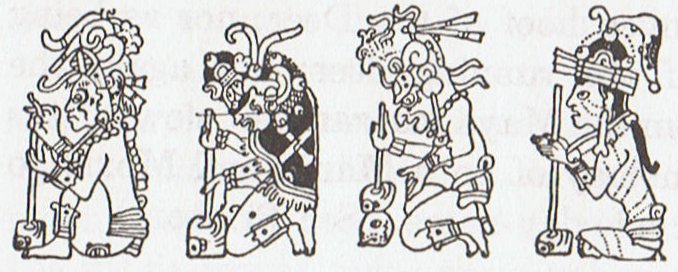5. Next we should consider how to put the text on the G tablet in parallel with the features of the time-space map (and with the geographical features on Easter Island). It is not a question of if but a question of how. Although the kuhane went beyond Anakena the goal of her voyage had been accomplished. ... The dream soul came to Rangi Meamea and looked around searchingly. The dream soul spoke: 'Here at last is level land where the king can live.' She named the place 'Rangi Meamea A Hau Maka O Hiva'. The mountain she named 'Peke Tau O Hiti A Hau Maka O Hiva'. The dream soul moved along a curve from Peke Tau O Hiti to the mountain Hau Epa, which she named 'Maunga Hau Epa A Hau Maka O Hiva'. The dream soul went to the other side of the mountain Hau Epa. As soon as the dream soul looked around, she saw the sand (beach), which was very white and light. She remained there and explored everything. After she had looked around carefully, the dream soul of Hau Maka said, 'Ah! This is the place that will serve as a residence for the king. She named the place 'Oromanga A Hau Maka O Hiva' and also named the neighboring bay 'Hanga Moria One A Hau Maka O Hiva'. The dream soul stepped forth lightly and reached Papa O Pea. She carefully looked around for a place where the king could settle down after his arrival and gather his people around (? hakaheuru). Having assembled his people (?) and having come down, he would then go from Oromanga to Papa O Pea, so went the speech of the dream soul. She named the place 'Papa O Pea A Hau Maka O Hiva'. She then hastened her steps toward Ahu Akapu. There she looked again for a residence of the king. Again the dream soul of Hau Maka spoke: 'May the king assemble his people (?) and may he come in the midst of his people from Oromanga to Papa O Pea. When the king of Papa O Pea has assembled his people (?) and has come to this place, he reaches Aha Akapu. To stay there, to remain (for the rest of his life) at Ahu Akapu, the king will abdicate (?) as soon as he has become an old man'. She named the place 'Ahu Akapu A Hau Maka O Hiva'. The (entire) land she named 'Te Pito O Te Kainga A Hau Maka O Hiva' ... A cycle is like a circle, it comes back to its beginning:
When the clock has struck 12 a new cycle is beginning. Number 24 at Oromanga suggests the kuhane stations each is representing half a month. Therefore the birthplace together with the 3 residences probably measure 2 months. The cycle of Sun is measured up to 12, although we have divided the day into 2 halves after how Moon has 2 'faces'. The face of a clock can be said to correspond to the waxing phase of the month, the front side of the month, because the source of Moon's growth is Sun, who has only one 1 'leg' (like Tohil, cfr at The Mad Hatter) - the other cannot be seen because it is hidden behind (or in) 'the mountain').  My mauga ('mountain') glyph type is probably associated with how at the end of the orbit of a luminary in the sky it looks for our eyes as if it was extinguished, like all fires.
I guess the rhomb figure of my mauga prototype is a picture of the 'square earth' with the idea to compare it with the earth beneath our feet (which hides half the cycle of Sun from our view). This my conclusion came early and was based on e.g. how the day of Venus in the calendar of the week (Hb9-48--50) has a mauga sign followed by what evidently must be her appearances as morning star and evening star:
The name of the glyph type in Gb5-24 is hakaariki ('to make a king'), which I find appropriate for a glyph in position 5-24 ('fire' in conjunction with 'midnight'). 472 (the number of glyphs in the G text, = 8 * 59) is more than necessary to cover 28 half-months. There seems to be 32 - 28 = 4 halfmonths more glyphs in the text than what corresponds to a 'great month' (7 * 59 = 413). Maybe it can be explained as an overlap from the preceding cycle:
The 'new land' will then not arrive until with manu kake in Ga3-1, and possibly it is 'born' by Spica (Ana-tipu) and Venus (because Ga2-29 can be considered as the 3rd glyph of line a3):
Tagata in Gb5-6 should then indicate where the 300 days of 'the new land' will be terminated. 5 * 6 = 30(0). The 16 - 2 = 14 glyph lines from a3 up to and including b8 can be divided in two halves:
The text must have 57 + 199 + 216 glyphs in order to cover 8 * 59 = 472 days, and I have so far solved the problem of why there are only 471 glyphs on the tablet by suggesting Gb8-30 should be counted twice, both as the last and the first glyph in the calendar. The glyphs can be interpreted to confirm there is a new season beginning with Gb2-1:
|
||||||||||||||||||||||||||||||||||||||||||||||||||||||||||||||||||||||||||||||||||||||||||||||||||||||||||||||||||||||||||||||||||||||||||||||||||||||||||||||||||||||||||||||||||||||||||||||||||||||||||||||||||||||






